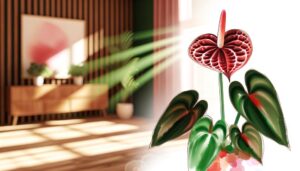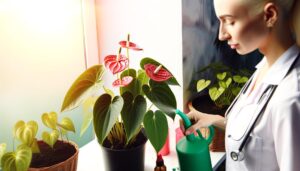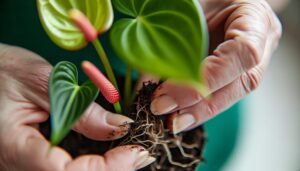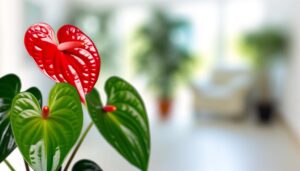How to Save My Anthurium Plant – A Step-by-Step Guide
Start by evaluating your anthurium's health. Examine leaves and roots for discoloration, pests, or signs of decay.
Ensure your plant receives ample, indirect sunlight to prevent etiolation and leaf scorch. Water when the topsoil dries, and use distilled water to evade mineral buildup.
Maintain humidity at 60-80% using a humidifier or humidity tray. Prune dead or yellowing leaves to enhance airflow and health.
Use a balanced fertilizer with a 3-1-2 N-P-K ratio every 6-8 weeks. Diligently check and treat for pests like aphids and mealybugs.
These steps establish a sturdy foundation for your plant's recovery and ongoing growth.
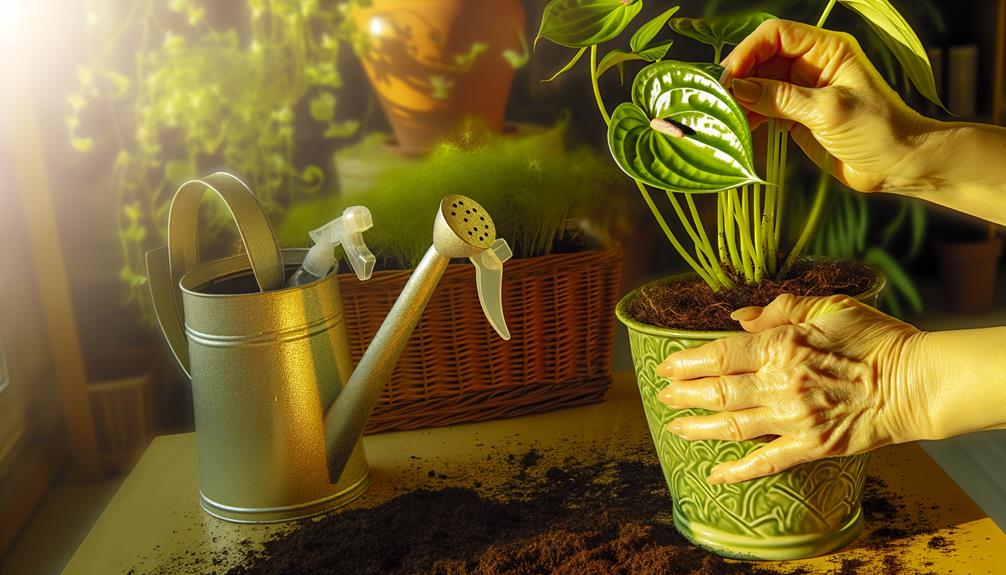
Key Takeaways
- Inspect leaves, stems, and roots for signs of discoloration, wilting, or pests.
- Adjust light conditions to ensure bright, indirect sunlight and avoid leaf scorch.
- Water thoroughly, letting the topsoil dry out between waterings to prevent root rot.
- Maintain humidity levels between 60-80% using a humidity tray, misting, or a humidifier.
- Use a balanced, slow-release fertilizer with a 3-1-2 N-P-K ratio every 6-8 weeks.
Assess Plant Health
Begin by meticulously examining the anthurium's leaves, stems, and roots for any signs of discoloration, wilting, or pests.
Check the leaves for chlorosis, necrosis, or unusual spots. Healthy foliage should be vibrant green, free from blemishes.
Inspect the stems for any signs of softening or lesions, which could indicate fungal or bacterial infections.
Gently unearth the plant to scrutinize the roots. Healthy roots appear white or light tan and feel firm. Brown, mushy roots suggest root rot.
Use a magnifying glass to detect pests like aphids, spider mites, or mealybugs.
Document your observations, noting any abnormalities. This thorough examination will form the baseline for diagnosing issues and implementing appropriate horticultural interventions for your anthurium's recovery.
Identify Common Issues
Several common issues can plague anthurium plants, including improper watering, inadequate light, nutrient deficiencies, and pest infestations.
You need to systematically diagnose the problem to effectively treat your plant. Start by examining the root system for rot, which indicates overwatering. Yellowing leaves often signal nutrient deficiencies or poor drainage.
Next, inspect the leaves and stems for pests like aphids, mealybugs, or spider mites, which can be identified by visible insects or webbing.
- Root Rot: Caused by overwatering or poorly draining soil.
- Yellowing Leaves: Often due to nutrient deficiencies or inadequate drainage.
- Pest Infestations: Look for aphids, mealybugs, or spider mites.
Careful observation and targeted intervention are essential for restoring your anthurium's health.
Check Light Conditions
Ensuring your anthurium receives the right amount of light is crucial for its growth and overall health. Position your plant in an area where it gets bright, indirect sunlight. Direct sunlight can cause photoinhibition and chlorophyll degradation, leading to leaf scorch.
Conversely, insufficient light can result in etiolation, where the plant stretches and becomes leggy. Aim for a light intensity of around 10,000 to 20,000 lux. If natural light is inadequate, consider using full-spectrum grow lights, which emit the necessary wavelengths for photosynthesis.
Monitor the plant's photoreceptive response by observing the leaf color and orientation. Yellowing or drooping leaves may indicate improper light conditions. Adjust the light exposure accordingly to maintain best photosynthetic efficiency and sustain your anthurium's energy.
Monitor Watering Habits
To maintain ideal soil moisture levels for your anthurium, water the plant thoroughly but allow the top 1-2 inches of soil to dry out between waterings. This practice guarantees that the roots receive sufficient hydration without becoming waterlogged, which can lead to root rot. Use a moisture meter to measure soil moisture accurately.
Make sure the pot has drainage holes to prevent water accumulation.
Use distilled or rainwater to avoid mineral buildup in the soil.
Schedule watering based on environmental conditions, adjusting for seasonal changes.
Implementing these watering techniques will promote prime plant health and growth. Regularly check the soil moisture and adjust your watering frequency as needed to maintain the delicate balance required for anthuriums.
Evaluate Humidity Levels
Maintaining an ideal humidity level of around 60-80% is crucial for anthurium health, as these tropical plants flourish in high-humidity environments. To achieve this, you can use a humidity tray, misting, or a room humidifier. A hygrometer will help you monitor the humidity accurately. Place the hygrometer near the plant and check it daily. If humidity drops below 60%, take corrective actions immediately. Here's a quick reference table for humidity management:
| Humidity Level | Action Required | Tools Needed |
|---|---|---|
| 60-80% | Ideal, maintain level | Hygrometer, Mist Spray |
| <60% | Increase humidity | Humidifier, Pebble Tray |
| >80% | Decrease humidity | Dehumidifier |
| 70-75% | Perfect for growth | Hygrometer |
| 65-70% | Acceptable range | Mist Spray |
Ensure consistent monitoring to keep your anthurium thriving.
Inspect Soil Quality
Another critical aspect of anthurium care involves inspecting the soil quality to guarantee maximum nutrient availability and proper drainage. Start by analyzing the soil texture. Anthuriums thrive in a well-aerated mix that allows for both moisture retention and excess water runoff. Check for:
- Organic Matter: Ensure the soil contains adequate organic materials like peat moss or coco coir to retain moisture.
- pH Levels: Anthuriums prefer slightly acidic to neutral soil (pH 5.5-6.5). Use a pH meter to confirm this range.
- Compaction: Overly compacted soil can restrict root growth and drainage. Loosen the soil or consider repotting with a more suitable mix.
Fertilize Appropriately
Make certain you're providing your anthurium with a balanced, high-phosphorus fertilizer during its growing season to promote vibrant blooms and robust growth. Utilize a 10-30-10 NPK (Nitrogen-Phosphorus-Potassium) formula, which supports flower development and root strength.
Dilute the fertilizer to half the recommended strength to prevent nutrient burn. Apply every 6-8 weeks during the spring and summer months, when the plant's metabolic processes are most active.
Always water the soil thoroughly before fertilizing to guarantee even nutrient distribution and avoid root damage. Monitor the plant for signs of over-fertilization, such as leaf tip burn or yellowing foliage.
Adjust the frequency and concentration based on your plant's specific needs and growth response.
Prune Damaged Leaves
After ensuring proper fertilization, you'll also need to prune any damaged leaves to maintain your anthurium's health and aesthetic appeal. Utilize sterilized pruning shears to prevent pathogen transmission.
Carefully examine the plant, identifying leaves with chlorosis, necrosis, or mechanical damage. Cut the damaged leaves at their base, near the petiole junction, ensuring a clean cut to facilitate healing.
Remember to:
- Inspect Regularly: Frequent inspections help you catch and address leaf damage early.
- Sanitize Tools: Always disinfect your pruning tools with isopropyl alcohol before and after use to prevent disease spread.
- Dispose Properly: Discard pruned leaves away from the plant to avoid potential contamination.
Repot if Necessary
When your anthurium exhibits signs of being root-bound or its soil has degraded, it's time to think about repotting to guarantee continued growth and essentiality.
First, select a pot that's 2 inches larger in diameter than the current one to secure adequate root expansion. Gently remove the plant, taking care to minimize root damage. Inspect the root system for any signs of rot or disease, trimming away compromised sections with sterilized scissors.
Prepare a well-draining potting mix containing a combination of peat, pine bark, and perlite. Position your anthurium in the new pot, ensuring the root ball is centered. Fill in with the potting mix, firming it gently around the roots.
Water thoroughly to settle the soil.
Control Pests and Diseases
To ensure your anthurium thrives, it's crucial to regularly monitor for common pests like aphids, mealybugs, and spider mites, as well as diseases such as root rot and fungal infections.
Inspect the leaves and stems for any signs of infestation or unusual discoloration. Use insecticidal soap or neem oil to treat pests; apply as directed to avoid phytotoxicity. For diseases, maintain proper soil drainage and avoid overwatering to prevent root rot.
- Aphids: Small, green or black insects that cluster on new growth.
- Mealybugs: White, cotton-like masses on leaves and stems.
- Spider Mites: Tiny, spider-like creatures causing stippled or yellowing leaves.
Consistent vigilance and timely intervention will safeguard your plant from these threats, promoting robust growth and vibrant blooms.
Maintain Regular Care
Consistent and thorough care, including regular watering, ample lighting, and proper fertilization, maintains your anthurium plant's peak health and vibrant blooms.
Water your anthurium when the top inch of soil is dry, ensuring the water drains well to prevent root rot.
Position your plant in indirect, bright light; direct sunlight can scorch the leaves, while insufficient light hinders flowering.
Use a balanced, slow-release fertilizer with a 3-1-2 N-P-K ratio every six to eight weeks during the growing season.
Prune dead or yellowing leaves to promote healthy growth and airflow, reducing the risk of fungal infections.
Regularly inspect the leaves for signs of stress or nutrient deficiencies, adjusting care routines as needed to sustain prime plant strength.
Conclusion
To sum up, saving your anthurium requires careful evaluation and consistent attention. By examining plant health, tweaking light levels, and following correct watering practices, you'll promote flourishing foliage.
Assess humidity, remove surplus moisture, and eliminate pests promptly. Trim troublesome sections and, if necessary, repot responsibly. Consistently review routines to maintain strong growth.
With these evidence-based measures, your anthurium won't only endure but flourish, displaying magnificent, enduring beauty. Remain steadfast, and your plant will thrive adeptly.

